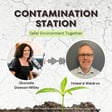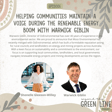
Emerging Contaminants, Microplastics, and PFAS with Dr Bob Symons
Bob Symons serves as the Regional Technical Manager for Eurofins Environment Testing Australia & Aotearoa New Zealand, where he oversees contaminants of emerging concern and contributes to the PFAS global peer group.
Holding a Ph.D. in Environmental Analytical Chemistry from La Trobe University and an undergraduate degree from Victoria University in Melbourne, Bob brings a wealth of academic expertise to his role. He has previously served as a member of the NATA (National Association of Testing Authorities, Australia) Life Sciences Accreditation Advisory Committee and currently acts as a Technical Assessor for ISO/IEC 17025 as well as a committee member of ALGA's special interest group on Emerging Contaminants.
Bob's research pursuits have primarily focused on the analysis of persistent organic pollutants (POPs), encompassing dioxins, dioxin-like PCBs, PBDEs, PPCPs, and PFAS, employing advanced mass spectrometric techniques. Notably, he has played a pivotal role in pioneering commercial microplastics analytical methodologies within Australia, underscoring his commitment to advancing environmental testing capabilities.
In this episode you’ll learn about emerging contaminants such as microplastics and PFAS. Shonelle and Bob also discuss rising concerns surrounding environmental waste from pharmaceuticals and personal care products, as well as the safe disposal of electronics, including smartphones, lithium-ion batteries, and electric vehicle batteries.
Bob shares his advice to those working in local council to ask lots of questions when working to manage contaminated land, and where needed to employ the help of laboratories like Eurofins Emerging Contaminants Laboratory or the Australian Laboratory for Emerging Contaminants at the University of Melbourne.
-----
Are you a local NSW council member looking for more resources like this?
You are invited to join the Local Government NSW Contaminated Land Network!
Local Government NSW (LGNSW) hosts a free, online network for council staff on the topic of contaminated land. The network includes an online forum for collaboration, information sharing and announcements about contaminated land regulation, guidance and training opportunities. Monthly meetings are held on themes that were set by the network participants, with presentations from regulators, technical experts, and case studies by councils.
Since the contaminated land network commenced in December 2023, more than 50% of NSW councils have joined, with over 200 participants. Feedback shows that councils are benefitting greatly from the network meetings and discussion on the platform, and we are pleased to invite you to join us.
To join the network, please use this link: https://lgsa.wufoo.com/forms/w1rf0os910rxyl6/
The contaminated land network forms part of a project called “Councils Managing Contaminated Land Together” funded by the NSW Environment Protection Authority (NSW EPA) to support capacity building and informed decision-making by those involved in contaminated land management in councils.
We hope to see you on the network soon!



















